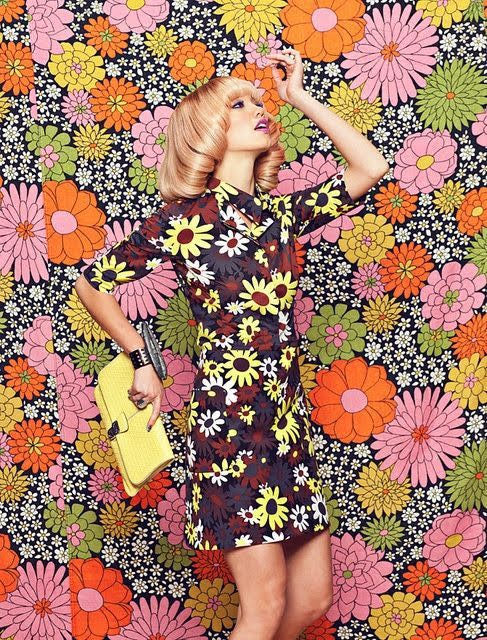
The 1960s: From Homemaker to Hippie Chic
The 1960s: From Homemaker to Hippie Chic
By Paige McKirahan
The 1960s was a truly transitional decade filled with experimentation and defiance. In the earlier years, it was very reminiscent of the conservative styles popularized in the ‘50s, but the late ‘60s were the complete and utter opposite. This contrast makes you wonder if the extreme traditional values of the previous decade created this opposition where women showed more skin and were more flamboyant than ever. The world’s fashion leaders were shifted as the overwhelming British Invasion had to do with more than just The Beatles and Twiggy. The London look trumped Parisian couture and modern, youthful styles took hold of the public as new fashion icon’s bold aesthetics shook the industry to its core.

In the beginning of the decade, Jackie Kennedy was the “it” girl of fashion; her style as simple, clean, well-tailored, and perfectly cohesive. She wore collarless dresses with one large top button, accessorizing with pillbox hats, sensible heels, and Chanel bags that were widely popularized in the ‘50s. Her global influence came to a screeching halt after the assassination of her husband, President John F. Kennedy, and she was removed from the public eye.
Women now had to discover a new fashion inspiration and found it in pop culture icons Brigitte Bardot and Mary Quant. Quant's style moved away from stiff, “adult” fashions and leaned towards youthful, short silhouettes with bold prints and accessories. Bardot, on the other hand, was very different than both Kennedy and Quant; her “tacky” and bold style was unlike any others that we had seen before and she was so influential that her pink gingham wedding dress with lace trim started a movement all on its own. We can also thank Brigette for popularizing the off the shoulder look, affectionately known as the Bardot neckline, that has come back into circulation in the past few years.

Brigette Bardot sporting her namesake neckline
(image credit pinterest.com)
As the decade zoomed forward, experimentation was brought to the forefront with mod style. Designers began revolting against traditional, waist cinching styles from the ‘50s and used the youth rebellion spreading from England to garner massive profits. The mod look boasted miniskirts, colored tights, low heels, mannish jackets, and ties. Shift dresses became trendy and their hem lengths were directly related to how women felt about their own sexual liberation, giving them a power over their own sexuality that was previously unheard of.

One of fashion’s most iconic faces, a icon known to the public as Twiggy, commonly modeled this style and had women stepping into freeing clothing that allowed personal expression. Colors and prints were inspired greatly by the pop and modern art movements, with bright hues, stripes, and Campbell’s soup cans adorning everything from dresses to bags.

Supermodel Twiggy in a mod shift dress
(photo credits to pintrest.com)
This rebellion also is responsible for the birth of the hippie movement, which was a political anti-fashion statement that was so popular it became a mainstream trend. The late ‘60s saw an earthier hippie style than the 1970s and the more colors, the better. Extremism was a huge part of this form and it affected everything from accessory choice to silhouettes. Hats were oversized, vests were knee length, and coats drug the floor. Folk motifs were front and center, influencing clothing and jewelry alike with ethnic motifs. There were no rules with this type of fashion; you marched to the beat of your own drum with no regard for outside judgement.
The jewelry of this decade still loved the longstanding costume style, but designs became bolder and increasingly more expressive. Many jewelry producers began experimenting with lower cost materials, rejecting the idea that jewelry represented status. Textured gold was still popular, yes, but plastics like vinyl, resin, and Perspex could be produced in mass quantities for a very low cost. The Pop Art movement that was influencing fashion made its way into accessories, with large geometric shapes complimenting the simple shift dress silhouette.

Floral motifs that have been used in jewelry for decades’ prior were revived in a big way as the birth of the Hippie movement and Flower Power trend paired with the new plastics of the time allowed the designs to become bold and colorful. Long, dangling earrings also came into fashion as shorter hairstyles were in and clip earrings were out. Large bangles and statement rings were ‘60s staples and were easy options to update outfits that need a little bit more va-va-voom. Lea Stein was one of the most popular designers of the time; after she started her company in 1957, she began manufacturing buttons for apparel. She then made her way into jewelry and used layers of colored cellulose acetate to create her trademark character pieces.

Though this decade seems to have dipped its toes in multitude of differing trends, the ‘60s made its mark in the fashion industry and changed style forever. People no longer felt the need to conform to society’s idea of stylish and instead started dressing in a way that expressed their personalities and taste. I think everyone should be a little rebellious in fashion because without rebellion, how do will we stand out? To start a fashion rebellion of your own, head over to our '60s collection to find pieces that express who YOU are!


